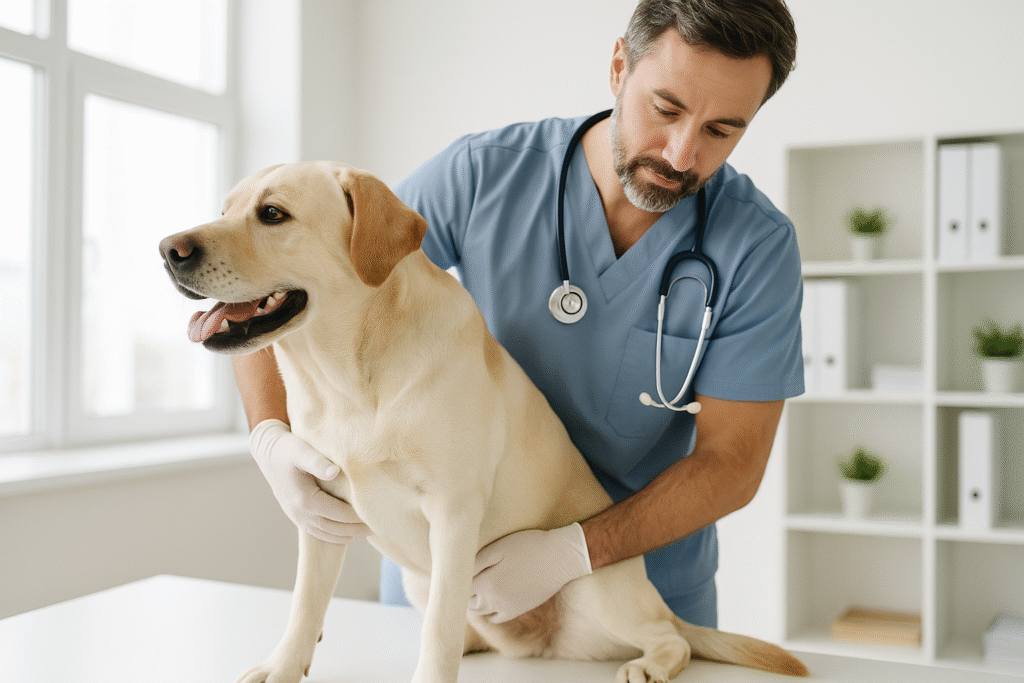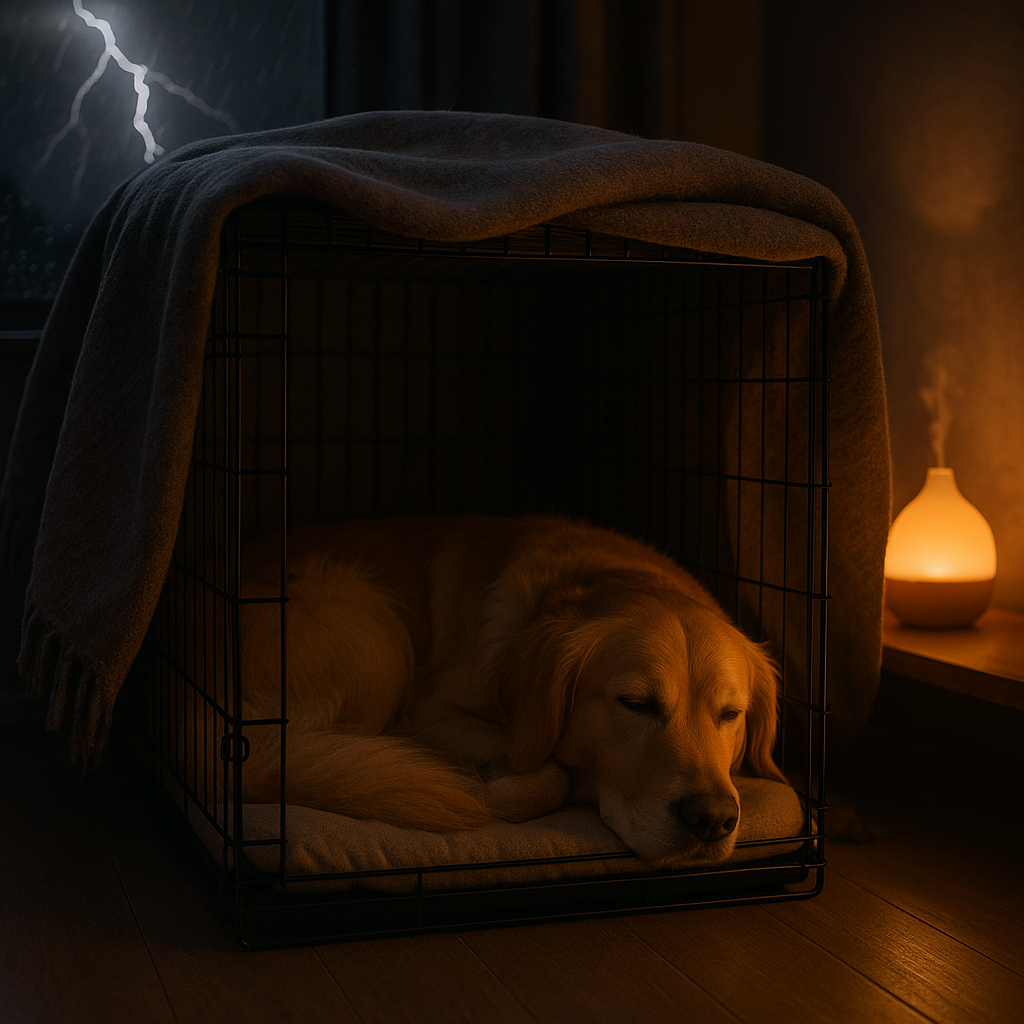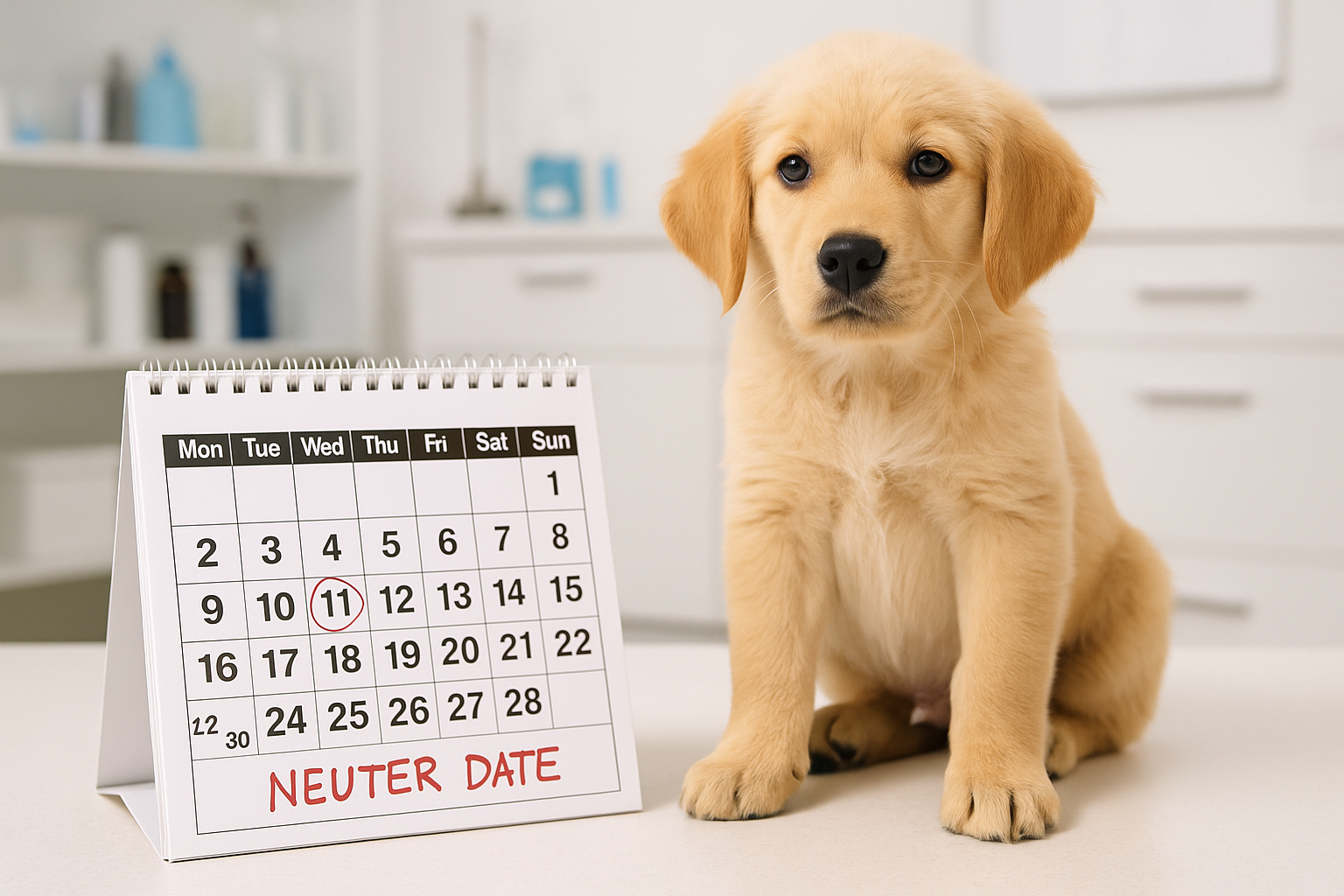Medical Disclaimer: This article is for informational purposes only and does not substitute professional veterinary advice. Always consult your veterinarian before making decisions about your dog’s health or surgery.
Deciding when to neuter a dog isn’t as simple as picking a date on the calendar. As a practising veterinarian in Canada, I’ve had countless owners ask, “Should I neuter now, or wait?” The truth is, the right timing depends on your dog’s breed, size, and health risks. I’ve seen first-hand how neutering too early can lead to joint issues in large breeds like Golden Retrievers, while delaying too long can increase behavioural problems in others.
In this updated 2025 vet-backed guide, you’ll learn exactly when to neuter a dog for optimal health — based on breed-specific data, major veterinary studies, and years of clinical experience. Whether you have a 10-pound Yorkie or a 100-pound Rottweiler, this article will help you make an informed, confident decision.
🐾 Key Takeaways: When to Neuter a Dog (At a Glance)
- There’s no one-size-fits-all answer for when to neuter a dog — it varies by breed, sex, and size.
- Small breeds (<20 kg): Safe to neuter around 6–9 months.
- Large breeds (>30 kg): Best to wait until 18–24 months to reduce joint and cancer risks.
- Benefits of neutering: Prevents testicular cancer, unwanted litters, and may reduce aggression.
- Potential risks if neutered too early: Orthopedic issues, certain cancers (like lymphoma, osteosarcoma), or behavior changes.
- Consult your vet to individualize timing, especially for working, sporting, or high-risk breeds.
👩⚕️ Veterinarian Tip: Ask your vet about breed-specific studies when deciding when to neuter a dog—it can impact your pet’s long-term health and quality of life.
Table of Contents
Why Timing Neutering Matters
What Is Neutering?
Neutering is the surgical removal of a male dog’s testicles. Also called “castration,” this procedure makes the dog sterile and significantly reduces levels of testosterone. It’s commonly done under general anesthesia and is considered a routine surgery in veterinary clinics across Canada.
Understanding when to neuter a dog is key—not just whether to do it. The timing can influence everything from growth plate development to the risk of certain diseases.

Common Reasons Dog Owners Consider Neutering
Pet owners often ask about neutering for reasons like:
- Preventing unwanted litters
- Reducing behaviors like mounting, roaming, or urine marking
- Lowering the risk of testicular cancer
- Fulfilling requirements for daycare, boarding, or travel
- Managing aggression or dominance issues in multi-dog homes
These reasons are valid—but none should be considered in isolation. Why? Because when you neuter a dog is just as critical as the decision to neuter itself.
Why “One-Size-Fits-All” Doesn’t Work
Years ago, vets routinely recommended neutering all male dogs at six months. But recent research, particularly from UC Davis and other major veterinary institutions, reveals that early neutering can lead to orthopedic problems and increase cancer risks in certain breeds.
What I’ve seen in practice supports this shift. In my Ottawa clinic, I’ve noticed fewer joint problems in retrievers and shepherds whose owners delayed neutering until after 18 months. This mirrors what the latest data tells us.
That’s why deciding when to neuter a dog should be tailored—not templated.
When to Neuter Based on Science
From “Six Months” to Breed-Specific Guidelines
For decades, the go-to advice for when to neuter a dog was between 6 and 9 months. But thanks to a growing body of veterinary research, we now know that early neutering isn’t ideal for every dog—especially not for large and giant breeds.
A landmark study from UC Davis Veterinary Medicine by Hart et al., 2020 analyzed over 35 popular breeds and found that neutering too early may increase the risk of joint disorders, such as hip dysplasia and cruciate ligament tears, as well as certain cancers like lymphoma and osteosarcoma.
This research has changed how vets, myself included, advise pet parents on when to neuter a dog. Now, we take into account the dog’s breed, sex, and body size to reduce long-term health risks.
Breed Size and Suggested Neutering Age
Different sizes = different timelines. Here’s a science-backed guideline to help:
| Breed Size | Suggested Neuter Age (Males) | Suggested Spay Age (Females) |
| Small (<20 kg) | 6–9 months | After first heat or 12 months |
| Medium (20–30 kg) | 12–18 months | 12–18 months |
| Large (>30 kg) | 18–24 months | 18+ months, after 1–2 heat cycles |
These recommendations are based on multiple studies, including Spain et al., 2004 (JAVMA), which examined long-term health outcomes of early spay/neuter.
Why Skeletal Maturity Matters
The main reason to delay neutering in larger breeds is to allow full skeletal maturity. Growth plates close later in big dogs—often after 18 months. Removing testosterone too early may interfere with this process, increasing the likelihood of:
- Hip dysplasia
- Elbow dysplasia
- Torn cranial cruciate ligaments (CCL injuries)
That’s why determining when to neuter a dog involves more than just age—it’s about developmental milestones.

Breed-Specific Neutering Recommendations
Not all breeds are affected equally by the timing of neutering. Thanks to data from the UC Davis studies and clinical observations, we now have breed-specific insights that guide us on when to neuter a dog for optimal health.
Large Breeds: Wait for Maturity
Certain breeds show clear evidence of increased health risks when neutered too early. Here are some examples:
- Golden Retriever (Males): Neutering before 12 months increases the risk of hip dysplasia and lymphoma.
- German Shepherd (Males): Early neutering is linked to cranial cruciate ligament (CCL) tears.
- Labrador Retriever (Males): Higher incidence of orthopedic disorders when neutered before 1 year.
- Rottweiler (Females): Spaying before 12 months can quadruple the risk of developing osteosarcoma, a deadly bone cancer.
- Vizsla (Both sexes): Early neutering increases the risk of mast cell tumors, hemangiosarcoma, and other cancers (Torres de la Riva et al., 2013).
In my own practice, I’ve seen many large breed dogs who were neutered too early and later presented with joint issues or mobility concerns by age 4–5. Timing matters.
Small Breeds: More Flexibility
Smaller breeds like Maltese, Pugs, Yorkies, and Shih Tzus don’t show the same elevated risk for joint or cancer-related complications after early neutering.
For most small breeds, neutering around 6–9 months is generally safe and appropriate—especially if behavior or population control is a concern. However, I still recommend discussing individual factors with your vet when deciding when to neuter a dog.
Breed Timing Summary Table
| Breed | Ideal Neuter Age (M) | Ideal Spay Age (F) | Notes |
| Golden Retriever | 18–24 months | 18+ months after 1st heat | Early neuter linked to cancer and joint disease |
| German Shepherd | 18–24 months | 18+ months after 1st heat | Higher risk of CCL injuries if neutered early |
| Labrador Retriever | 12–18 months | 12–18 months | Risk increases if neutered before 12 months |
| Vizsla | 12–18 months | 12–18 months | Neutering before 12 months raises cancer risk |
| Rottweiler | 18–24 months | 18–24 months after 2nd heat | Early spay quadruples osteosarcoma risk |
| Yorkshire Terrier | 6–9 months | 9–12 months after 1st heat | Early neuter generally safe |
Pros of Neutering Your Dog
Despite the timing debate, neutering remains a beneficial procedure when done at the right stage. Here’s what you gain when you neuter responsibly—and why knowing when to neuter a dog maximizes these benefits.
✅ Health Benefits
- Eliminates testicular cancer risk completely, since the testicles are removed.
- Reduces the risk of perianal tumors and some prostate conditions, such as benign prostatic hyperplasia (BPH).
- May lower the incidence of perineal hernias, especially in senior intact males.
✅ Behavioural Improvements
- Reduces roaming and urine marking: Testosterone drives these behaviors, which often lessen after neutering.
- May reduce mounting, territorial marking, and some types of aggression.
- Can lower the risk of dog fights in multi-male households.
It’s important to remember that neutering isn’t a cure-all. While it may reduce hormone-driven behaviours, training and socialization are still essential.
✅ Societal and Practical Advantages
- Prevents unwanted litters, contributing to lower shelter intake and euthanasia rates.
- Meets requirements for many daycares, dog parks, boarding kennels, and international travel.
- Can make insurance and licensing easier in some regions.
According to the Canadian Veterinary Medical Association (CVMA), neutering is a responsible decision that supports both public and pet health—provided it’s timed appropriately.
When discussing when to neuter a dog, these benefits are part of the bigger picture that balances medical, behavioural, and logistical needs.

Possible Side Effects of Neutering (Depending on Timing)
While neutering offers clear benefits, it’s not without potential drawbacks—especially if done too early. Understanding these helps dog owners make smarter decisions about when to neuter a dog.
⚠️ Orthopedic Concerns
In large and giant breeds, early neutering may interfere with the closure of growth plates. This can lead to:
- Hip dysplasia
- Elbow dysplasia
- Cranial cruciate ligament (CCL) ruptures
These issues can result in lifelong mobility problems and costly surgeries. This is one of the most compelling reasons when to neuter a dog should depend on size and breed.
⚠️ Increased Cancer Risks (Breed-Dependent)
Scientific studies have shown elevated risks for several types of cancer when dogs are neutered too early:
- Osteosarcoma (bone cancer) – particularly in Rottweilers and other large breeds
- Hemangiosarcoma – a fast-growing cancer of blood vessels
- Lymphoma – especially in retrievers
- Mast cell tumors – noted in Vizslas and Boxers neutered early
A 2013 PLoS One study confirmed that these cancer risks are timing-dependent, highlighting again why when to neuter a dog matters.
⚠️ Endocrine and Metabolic Effects
- Weight gain and obesity are common after neutering, especially if exercise and diet aren’t adjusted.
- Hypothyroidism risk may slightly increase, particularly in neutered males.
Dogs may need fewer calories after neutering. Ask your vet about adjusting your dog’s diet post-op.

⚠️ Behavioural Shifts (Not Always Positive)
While neutering reduces testosterone-driven behaviours, it doesn’t always “fix” every issue:
- Fear-related aggression or anxiety may increase in some dogs.
- Separation anxiety or noise phobias could become more pronounced.
- Neutering won’t eliminate behaviours that are already habit-based or linked to poor training.
These effects vary widely. That’s why behavioral history should be part of the conversation about when to neuter a dog.
Should You Wait? Key Questions to Ask
Making the right choice about when to neuter a dog means evaluating more than just age. Here are questions I ask clients during consults to help tailor the decision to their dog’s unique needs.
5-Minute Home Checklist for Dog Owners
Ask yourself:
✅ What breed and size is my dog?
Large breeds may need to wait for skeletal maturity. Small breeds may not.
✅ Does my dog have behavior issues now?
If aggression or mounting is hormone-driven, earlier neutering may help. But for anxiety-based behaviors, neutering could worsen them.
✅ Can I safely manage an intact male dog?
This includes supervision, no access to female dogs in heat, and secure fencing.
✅ Is my dog at genetic risk for orthopedic problems or cancer?
Talk to your vet if your dog is from a line with known issues like hip dysplasia or lymphoma.
✅ Do I plan to breed responsibly?
If not, neutering is usually the ethical choice—but timing is key.
Veterinary Red Flags: When Early Neutering May Be Necessary
In some cases, early neutering is still recommended:
- Cryptorchidism: If one or both testicles are undescended
- Severe inter-male aggression or dominance aggression
- Shelter/Rescue dogs to prevent accidental breeding
This is why individualized veterinary guidance is so important when determining when to neuter a dog.
Final Thoughts: A Balanced Approach to Neutering
Neutering is a valuable procedure with proven benefits—but timing is everything. Based on current evidence, veterinary consensus is shifting toward breed- and size-specific recommendations rather than the old six-month rule.
For small breeds, early neutering (6–9 months) is usually safe. But for larger dogs, particularly those over 30 kg, waiting until 18–24 months allows bones and joints to mature, potentially avoiding serious health problems later on.
As a vet, I always tell my clients this: the best time depends on your dog’s unique combination of breed, behavior, and risk factors. When in doubt, ask your veterinarian to walk you through the current research and how it applies to your pet.
Remember—knowing when to neuter a dog isn’t just about age. It’s about protecting your dog’s future health, mobility, and quality of life.
FAQs About Neutering Dogs
❓ What’s the best age to neuter a male dog?
It depends on your dog’s breed and size. Small breeds can typically be neutered around 6–9 months, while large breeds may benefit from waiting until 18–24 months. Talk to your vet to determine when to neuter a dog in your specific case.
❓ Will neutering calm my dog down?
Neutering may reduce behaviors driven by testosterone, such as roaming, marking, and mounting. However, it’s not a cure-all for aggression or anxiety. Behavioral training is still necessary for long-term improvement.
❓ Is neutering safe?
Yes, neutering is considered a routine surgery with minimal complications in healthy dogs. Most dogs recover within 7–10 days. As with any surgery, there are risks, but they are typically low in a well-equipped veterinary clinic.
❓ Can neutering too early stunt growth?
Yes, especially in large breeds. Early neutering may delay growth plate closure, leading to abnormal bone growth and orthopedic issues later. This is why vets now emphasize breed-based timing when deciding when to neuter a dog.
❓ What happens if I never neuter my dog?
Your dog may be at risk for testicular cancer, prostate issues, and increased roaming or aggression. Additionally, managing an intact dog requires diligence to avoid accidental litters or conflicts with other dogs.




